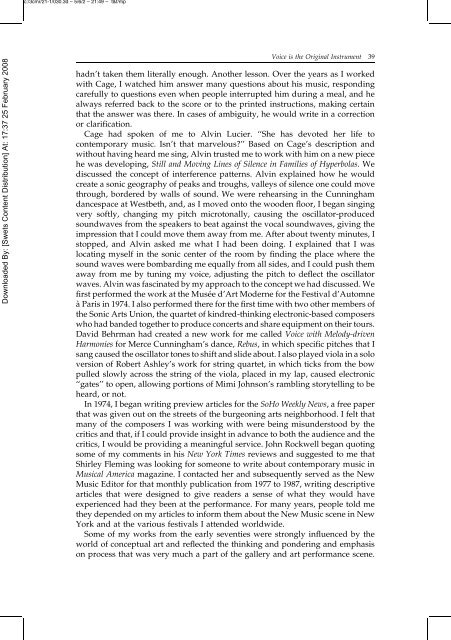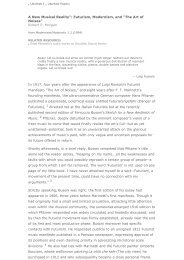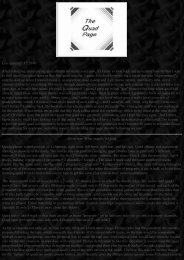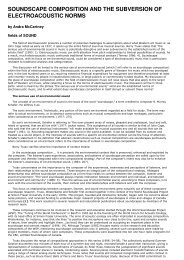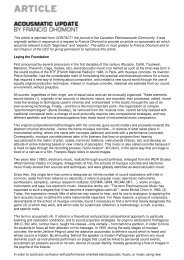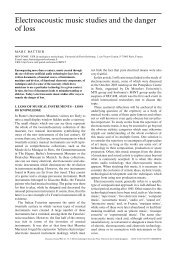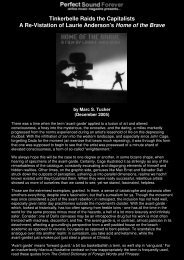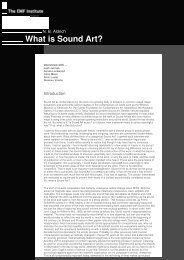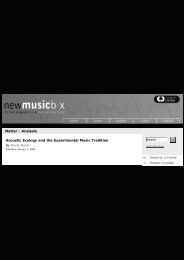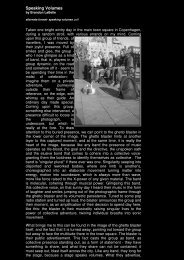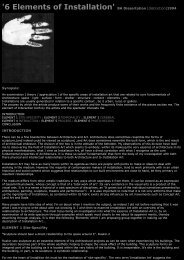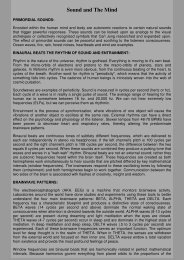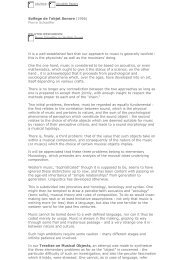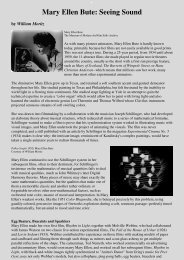La_Barbara-2002-Voice is the original instrument.pdf
La_Barbara-2002-Voice is the original instrument.pdf
La_Barbara-2002-Voice is the original instrument.pdf
Create successful ePaper yourself
Turn your PDF publications into a flip-book with our unique Google optimized e-Paper software.
c:/3cmr/21-1/030.3d ±5/6/2 ± 21:49 ± t&f/mpDownloaded By: [Swets Content D<strong>is</strong>tribution] At: 17:37 25 February 2008<strong>Voice</strong> <strong>is</strong> <strong>the</strong> Original Instrument 39hadn't taken <strong>the</strong>m literally enough. Ano<strong>the</strong>r lesson. Over <strong>the</strong> years as I workedwith Cage, I watched him answer many questions about h<strong>is</strong> music, respondingcarefully to questions even when people interrupted him during a meal, and healways referred back to <strong>the</strong> score or to <strong>the</strong> printed instructions, making certainthat <strong>the</strong> answer was <strong>the</strong>re. In cases of ambiguity, he would write in a correctionor clari®cation.Cage had spoken of me to Alvin Lucier. ``She has devoted her life tocontemporary music. Isn't that marvelous?'' Based on Cage's description andwithout having heard me sing, Alvin trusted me to work with him on a new piecehe was developing, Still and Moving Lines of Silence in Families of Hyperbolas. Wed<strong>is</strong>cussed <strong>the</strong> concept of interference patterns. Alvin explained how he wouldcreate a sonic geography of peaks and troughs, valleys of silence one could movethrough, bordered by walls of sound. We were rehearsing in <strong>the</strong> Cunninghamdancespace at Westbeth, and, as I moved onto <strong>the</strong> wooden ¯oor, I began singingvery softly, changing my pitch microtonally, causing <strong>the</strong> oscillator-producedsoundwaves from <strong>the</strong> speakers to beat against <strong>the</strong> vocal soundwaves, giving <strong>the</strong>impression that I could move <strong>the</strong>m away from me. After about twenty minutes, Istopped, and Alvin asked me what I had been doing. I explained that I waslocating myself in <strong>the</strong> sonic center of <strong>the</strong> room by ®nding <strong>the</strong> place where <strong>the</strong>sound waves were bombarding me equally from all sides, and I could push <strong>the</strong>maway from me by tuning my voice, adjusting <strong>the</strong> pitch to de¯ect <strong>the</strong> oscillatorwaves. Alvin was fascinated by my approach to <strong>the</strong> concept we had d<strong>is</strong>cussed. We®rst performed <strong>the</strong> work at <strong>the</strong> MuseÂe d'Art Moderne for <strong>the</strong> Festival d'AutomneaÁ Par<strong>is</strong> in 1974. I also performed <strong>the</strong>re for <strong>the</strong> ®rst time with two o<strong>the</strong>r members of<strong>the</strong> Sonic Arts Union, <strong>the</strong> quartet of kindred-thinking electronic-based composerswho had banded toge<strong>the</strong>r to produce concerts and share equipment on <strong>the</strong>ir tours.David Behrman had created a new work for me called <strong>Voice</strong> with Melody-drivenHarmonies for Merce Cunningham's dance, Rebus, in which speci®c pitches that Isang caused <strong>the</strong> oscillator tones to shift and slide about. I also played viola in a soloversion of Robert Ashley's work for string quartet, in which ticks from <strong>the</strong> bowpulled slowly across <strong>the</strong> string of <strong>the</strong> viola, placed in my lap, caused electronic``gates'' to open, allowing portions of Mimi Johnson's rambling storytelling to beheard, or not.In 1974, I began writing preview articles for <strong>the</strong> SoHo Weekly News, a free paperthat was given out on <strong>the</strong> streets of <strong>the</strong> burgeoning arts neighborhood. I felt thatmany of <strong>the</strong> composers I was working with were being m<strong>is</strong>understood by <strong>the</strong>critics and that, if I could provide insight in advance to both <strong>the</strong> audience and <strong>the</strong>critics, I would be providing a meaningful service. John Rockwell began quotingsome of my comments in h<strong>is</strong> New York Times reviews and suggested to me thatShirley Fleming was looking for someone to write about contemporary music inMusical America magazine. I contacted her and subsequently served as <strong>the</strong> NewMusic Editor for that monthly publication from 1977 to 1987, writing descriptivearticles that were designed to give readers a sense of what <strong>the</strong>y would haveexperienced had <strong>the</strong>y been at <strong>the</strong> performance. For many years, people told me<strong>the</strong>y depended on my articles to inform <strong>the</strong>m about <strong>the</strong> New Music scene in NewYork and at <strong>the</strong> various festivals I attended worldwide.Some of my works from <strong>the</strong> early seventies were strongly in¯uenced by <strong>the</strong>world of conceptual art and re¯ected <strong>the</strong> thinking and pondering and emphas<strong>is</strong>on process that was very much a part of <strong>the</strong> gallery and art performance scene.


